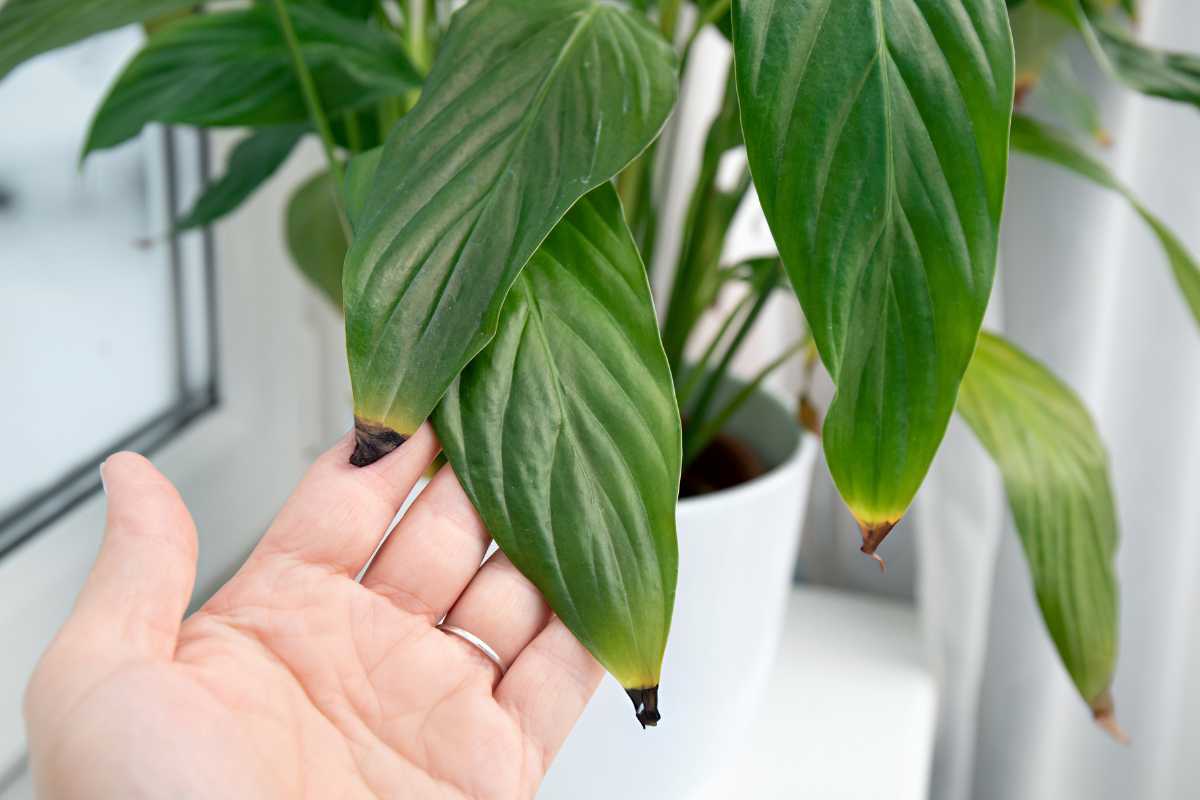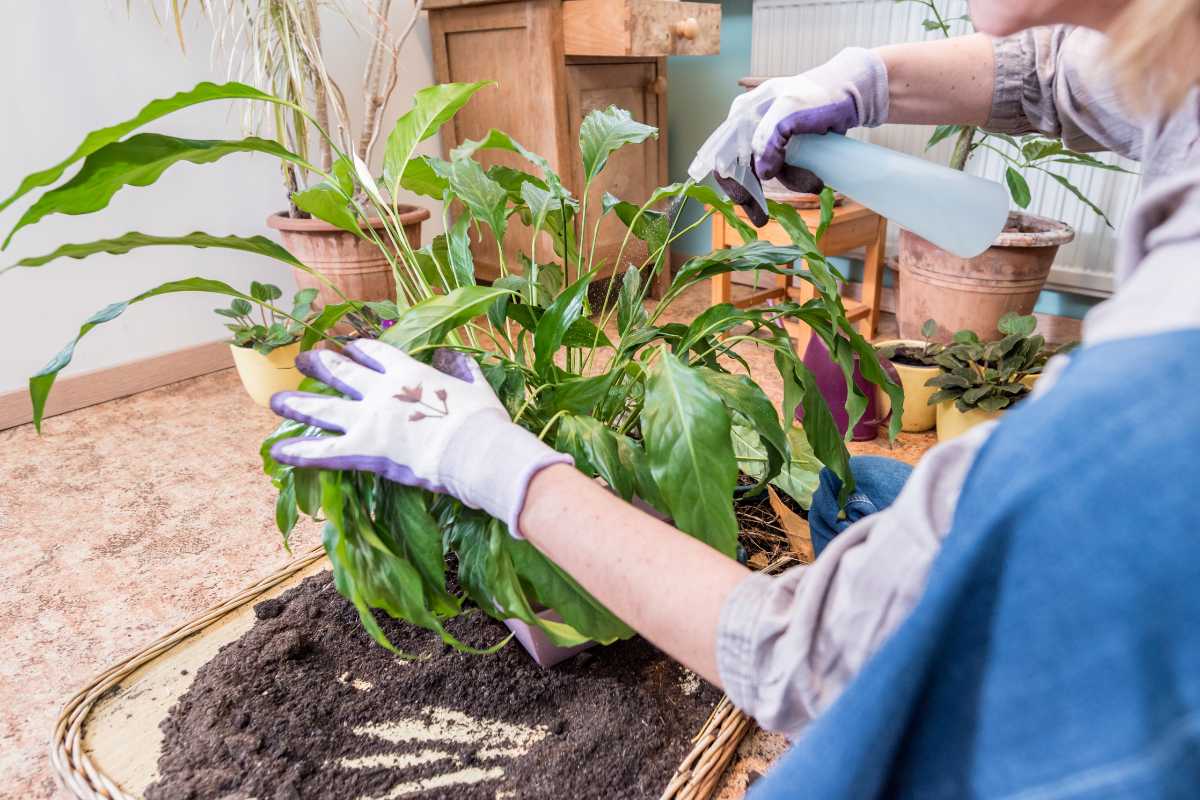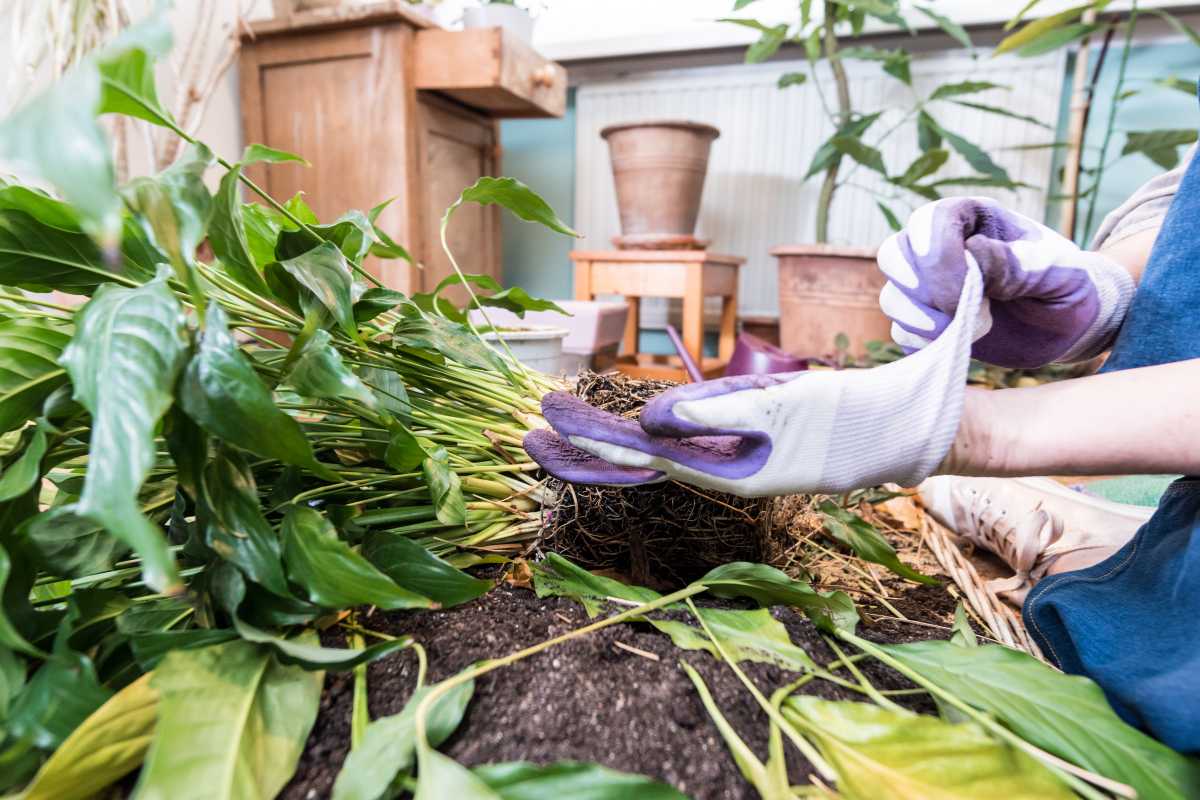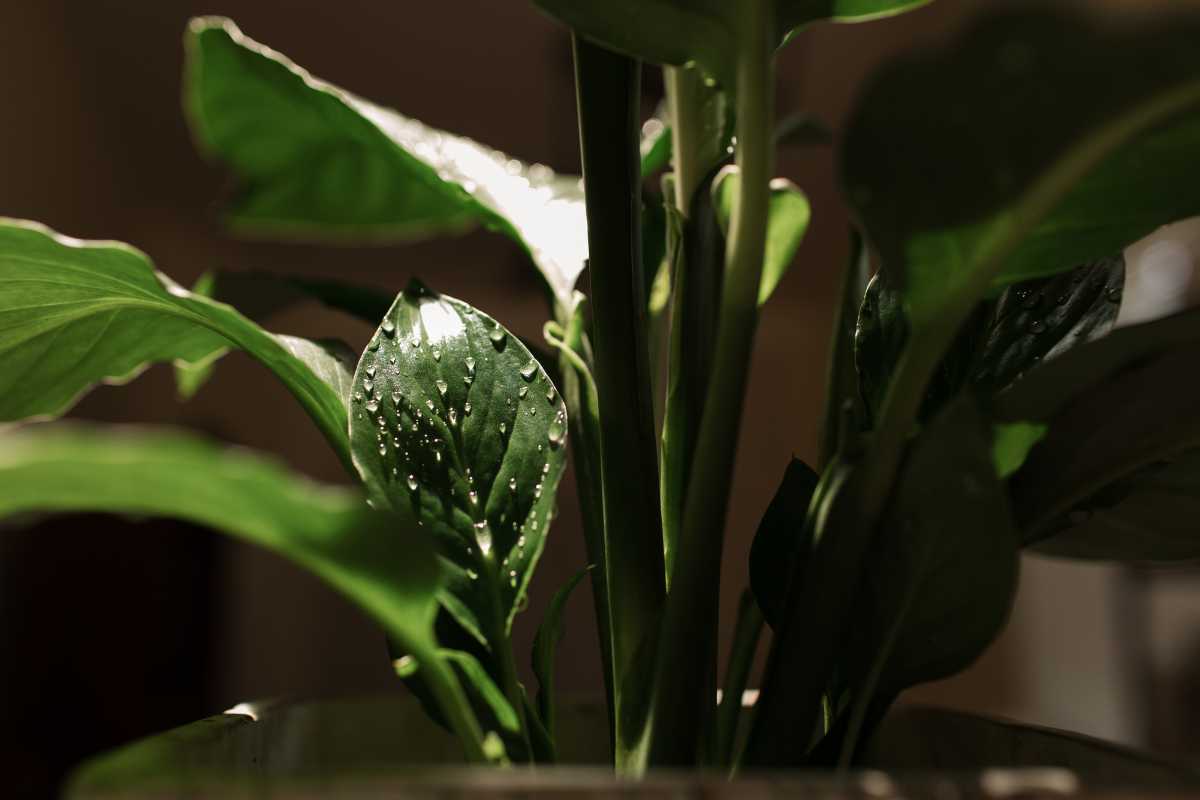The Peace Lily or Spathiphyllum is a well-loved indoor plant known for its striking deep green foliage and elegant, hooded white flowers. So, it can be quite disconcerting to find this beautiful houseplant sporting blackened leaves.
If you see your peace lily leaves turning black, fear not! This is usually an indication of a care and maintenance problem.
Let’s look at the most common reasons why the peace lily leaves are turning black. Identify the underlying cause and find a solution to revive your peace lily.
- Related article: How to Care for the Peace Lily Plant
7 Key Takeaways on Peace Lily Leaves Turning Black
- Black leaves on peace lilies usually indicate care issues that can be resolved.
- Poor water quality, especially from tap water, can lead to black spots on leaves.
- Both underwatering and overwatering can cause blackening of peace lily leaves.
- Over-fertilization can create salt build-up, preventing nutrient absorption and causing leaf discoloration.
- Peace lilies thrive in warm temperatures and can suffer if exposed to cold.
- Fungal infections often arise from consistently soggy soil, leading to black spots.
- Maintaining humidity levels above 50% is essential for healthy peace lily foliage.
Why Peace Lily Leaves Turn Black

Let’s see why your peace lily leaves might be turning black and find some easy solutions to help bring your plant back to life.
1. Water Quality Issues
Poor water quality is one of the primary reasons for foliage blackening. This can be at the root of your plant’s leaves turning black.
Most people water their houseplants with common city tap water. Tap water contains numerous impurities and chemicals. Two of the most prevalent are fluoride and chloride.
When these chemicals enter the soil bed, they will negatively affect the plant’s absorption of essential nutrients present. Your plant will begin to absorb fluoride and chloride, which are toxic, and doesn’t provide any soil nutrients.
The presence of chemicals and lack of nutrients will affect the color of foliage. The green leaves may turn yellow, brown, and/or develop black spotting.
- Read more: Why Peace Lily Leaves Are Turning Brown
Poor Water Quality Solution:
Use filtered water, distilled water, or collected rainwater to water your plants.
If you want to use tap water, leave the water out overnight for the chlorine, fluoride, and other impurities to evaporate or sink to the bottom of the container. You can also use a tap water conditioner to remove harmful chemicals, and you can easily find one on Amazon. I personally use this brand for my plants since it removes chlorine, chloramines, and heavy metals, while also buffering pH to improve soil health.
2. Improper Watering Issues
Peace lilies call tropical rain forests their native habitat. Therefore, they receive sufficient water thanks to the frequent rain in these locations.
That means your peace lily will require a bit more water than other houseplants that you may own. If you underwater your peace lily, its leaves may blacken.
But also be careful with high watering frequency. Overwatering can also contribute to the development of black leaves because your plant is left standing in water.
Improper Watering Solution:
Water your plant once or twice a week depending on the season and how quickly the soil dries. As a rule of thumb, do not water your plant until the top two inches of the soil bed are completely dry.
If you do see any black leaves, be sure to remove any black, decayed leaves.
3. Overfertilization Issues

Who would imagine that a plant can be fed too much! However, if a peace lily is over-fertilized, an excess of salt may build up in the soil bed.
Salt build-up clogs up the soil, impeding the root system from absorbing adequate water. If the roots do not absorb water, they will not be able to absorb nutrients either.
With the lack of absorption of specific nutrients such as magnesium, potassium, iron, and copper, the foliage will die because of necrosis. This is a primary reason for peace lily leaves to begin turning black, starting with the leaf tips.
Overfertilization Solution:
After removing any black leaves, place your plant in a sink to start removing excess fertilizer, excess salts and mineral deposits.
Turn on the tap and allow the water to run through the soil bed for several seconds. Allow the water to drain out and take out the high amounts of fertilizer left over. Then repeat the entire process three to four times.
Once the plant has drained thoroughly, it can be returned to its usual spot.
4. Cold Temperatures
As a tropical plant, the peace lily is not a cold-hardy houseplant. It will not survive in the cold. If the temperature drops below 25°C, the plant will suffer damage.
In colder environments, these plants are at risk of cold injuries because the lower temperatures disturb the plant’s metabolism. Consequently, the roots will not absorb water and the leaves will turn black.
Cold Temperature Solution:
If cold temperatures are responsible for leaves blackening, do not trim leaves for the moment. Your plant is in shock. It will require several days to recover from the shock.
First, place your peace lily in a warmer location. Greenhouses are an ideal environment in these situations. When temperatures return to normal springtime levels, you can prune the damaged leaves.
5. Fungal Infection and Root Rot

If the soil bed of your peace lily is constantly overly moist, it becomes the perfect breeding ground for fungal infections and root rot.
The first symptom of a fungal infection or root rot will be the appearance of black spots on leaves and the entire leaf may follow.
The problem with fungal infections is that they are not limited to where the spots appear, they may already have infected healthy-looking parts of your plant. Because of this, applying a fungicide is recommended to stop fungal growth.
Fungal Infection and Root Rot Solutions:
Remove spotted leaves immediately to prevent the spread of the fungus. Your plant may also be suffering from root rot due to being left standing in excess water or waterlogged soil.
Baking soda works well against fungal infections and is a gentler solution than chemical products. It’s a great homemade antifungal agent solution.
Put one tablespoon of baking soda in a spray bottle with one liter of water. Shake and agitate the mixture well, and then spray the leaves of your plant.If you prefer a simpler option, you can also buy a fungicide spray, which is effective at combating fungal infections and can save you time while keeping your peace lily healthy.
In the case of root rot, you need to remove the plant from the soil bed. Trim away any affected roots. Rinse the healthy roots and allow them to dry. Repot your plant in fresh potting soil. Wait a couple of days before resuming watering.
- Learn more: How to Repot Peace Lilies
6. Low Humidity Conditions

The peace lily is a tropical rainforest plant so it loves high humidity levels. For your plant to thrive and be healthy, its natural environment needs to be mimicked.
If you place your plant in a dry location with low humidity, its foliage will suffer. They will begin by wilting and then turn black.
When trying to identify the cause of your plant’s leaves turning black, check the level of humidity in the room where you have positioned them. If the humidity measures below 50%, the black leaves are a result of low humidity.
Low Humidity Solution:
A humidifier is the easiest solution for plants that require elevated humidity levels. Other options include misting your plant several times a week or grouping several plants together to raise the humidity level in the area.
Another simple solution is to create a pebble tray and place your plant pot on top of it. This will raise the humidity around the plant.
Take a tray and fill it with pretty pebbles, stones, or rocks. Proceed to fill the tray with water, then set your peace lily on top of it. The drainage holes in your plant’s container should not come into contact with the water in the tray.
General Tips to Prevent Peace Lily Leaves From Turning Black

Now that you know what can cause peace lily leaves to turn black, let’s take a look at how to prevent the leaf color from changing.
General tips for keeping your peace lily healthy and preventing leaves from turning black include:
- Position your plant in bright indirect sunlight, although it will also adapt to low and medium-light environments. Just keep the peace lily out of direct sunlight, like the majority of common houseplants.
- Fertilize monthly during the growing season with half-strength liquid fertilizer. Do not fertilize the remainder of the year during its dormancy period.
- Water weekly and perhaps biweekly during warmer weather.
- Keep your peace lily in a warm environment with a humidity level above 50%.
- Examine your plant regularly for signs of pest infestations or infections and treat immediately.
- Remove yellow, brown and black leaves from the peace lily, because they will not return to being green.
Peace Lily Leaves Turning Black Final Thoughts
If you want to keep your peace lily looking beautiful, make sure you provide it with the right environmental conditions. If you do not, you may find yourself having to replace your peace lily every few months.
The peace lily is an elegant plant that will bring beauty to any décor. With attentive care and maintenance, you can prevent your plant from developing black leaves.
Peace Lily Leaves Turning Black FAQs
1. Why Are My Peace Lily’s Leaves Developing Black Spots?
Black spots on peace lily leaves are often caused by bacterial or fungal diseases, which can result from soggy soil or soil with water that doesn’t drain well. The plant may also have a nutrient deficiency or be getting too little sunlight. To treat it, use insecticidal soap or homemade solutions to remove pests. Make sure your plant gets adequate light, but keep it in indirect light to prevent further issues.
2. Can Direct Sunlight Cause Black Leaves On My Peace Lily?
Yes, direct sunlight can cause leaf browning and black spots on your peace lily. These house plants prefer indirect light. Extended periods of direct sunlight can burn the leaves, causing black or brown leaves to appear. Moving your peace lily to a spot with filtered light can help prevent this problem.
3. Could A Lack Of Water Lead To Black Leaves On My Peace Lily?
Yes, a lack of water can cause black spots and leaf browning on your peace lily. Check the top inch of soil regularly; if it’s dry, your plant needs water. Be careful not to overwater, as soggy soil can lead to further problems. Keeping the soil slightly moist will keep the leaves healthy and prevent blackened areas.
4. How Does Nutrient Deficiency Contribute To Peace Lily Leaf Discoloration?
Nutrient deficiency is a common reason for black spots on peace lily leaves. Without a balanced fertilizer, the plant may not get the nutrients it needs, leading to black patches or brown leaves. Regularly using a balanced fertilizer can prevent nutrient deficiency and keep the leaves healthy.
5. What Are Some Garden Rescue Tips For Peace Lily Leaf Problems?
To rescue your peace lily from black spots and brown leaves, place it in indirect light and avoid overwatering. You can treat bacterial diseases with insecticidal soap or homemade solutions. Ensure the plant gets adequate light, but not too much direct sunlight, and make sure the soil is well-draining to avoid soggy soil.
You might be interested in these other peace lily articles:





Thanks for the information on peace lilies. I love it but was having trouble with mine. Thanks again.